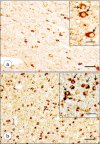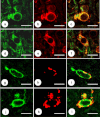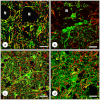Friedreich's ataxia causes redistribution of iron, copper, and zinc in the dentate nucleus
- PMID: 22562713
- PMCID: PMC3497958
- DOI: 10.1007/s12311-012-0383-5
Friedreich's ataxia causes redistribution of iron, copper, and zinc in the dentate nucleus
Abstract
Friedreich's ataxia (FRDA) causes selective atrophy of the large neurons of the dentate nucleus (DN). High iron (Fe) concentration and failure to clear the metal from the affected brain tissue are potential risk factors in the progression of the lesion. The DN also contains relatively high amounts of copper (Cu) and zinc (Zn), but the importance of these metals in FRDA has not been established. This report describes nondestructive quantitative X-ray fluorescence (XRF) and "mapping" of Fe, Cu, and Zn in polyethylene glycol-dimethylsulfoxide (PEG/DMSO)-embedded DN of 10 FRDA patients and 13 controls. Fe fluorescence arose predominantly from the hilar white matter, whereas Cu and Zn were present at peak levels in DN gray matter. Despite collapse of the DN in FRDA, the location of the peak Fe signal did not change. In contrast, the Cu and Zn regions broadened and overlapped extensively with the Fe-rich region. Maximal metal concentrations did not differ from normal (in micrograms per milliliter of solid PEG/DMSO as means ± S.D.): Fe normal, 364 ± 117, FRDA, 344 ± 159; Cu normal, 33 ± 13, FRDA, 33 ± 18; and Zn normal, 32 ± 16, FRDA, 33 ± 19. Tissues were recovered from PEG/DMSO and transferred into paraffin for matching with immunohistochemistry of neuron-specific enolase (NSE), glutamic acid decarboxylase (GAD), and ferritin. NSE and GAD reaction products confirmed neuronal atrophy and grumose degeneration that coincided with abnormally diffuse Cu and Zn zones. Ferritin immunohistochemistry matched Fe XRF maps, revealing the most abundant reaction product in oligodendroglia of the DN hilus. In FRDA, these cells were smaller and more numerous than normal. In the atrophic DN gray matter of FRDA, anti-ferritin labeled mostly hypertrophic microglia. Immunohistochemistry and immunofluorescence of the Cu-responsive proteins Cu,Zn-superoxide dismutase and Cu(++)-transporting ATPase α-peptide did not detect specific responses to Cu redistribution in FRDA. In contrast, metallothionein (MT)-positive processes were more abundant than normal and contributed to the gliosis of the DN. The isoforms of MT, MT-1/2, and brain-specific MT-3 displayed only limited co-localization with glial fibrillary acidic protein. The results suggest that MT can provide effective protection against endogenous Cu and Zn toxicity in FRDA, similar to the neuroprotective sequestration of Fe in holoferritin.
Figures










References
Publication types
MeSH terms
Substances
Grants and funding
LinkOut - more resources
Full Text Sources
Other Literature Sources
Medical

